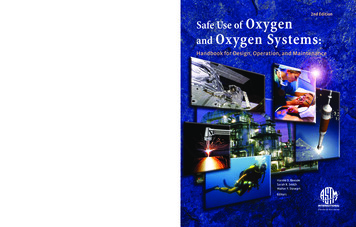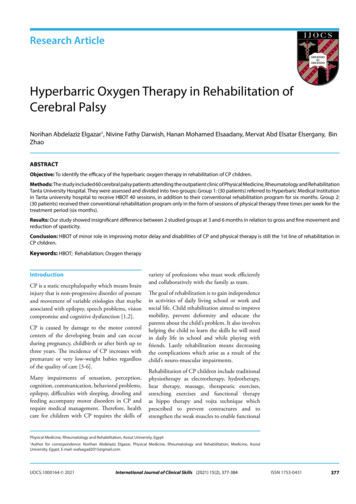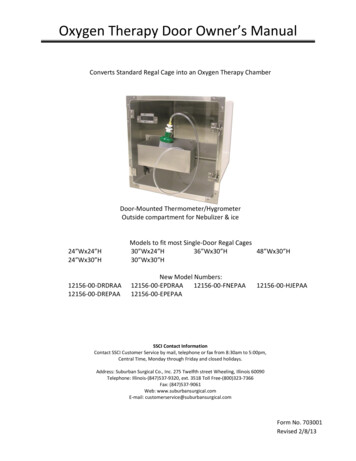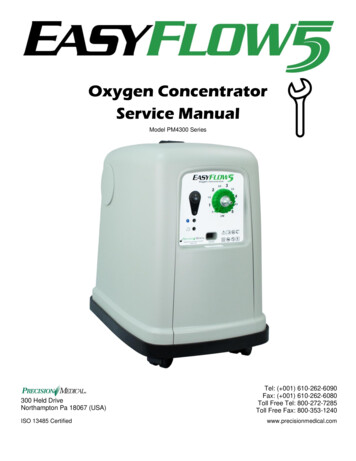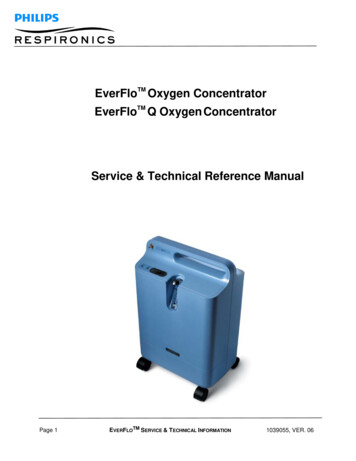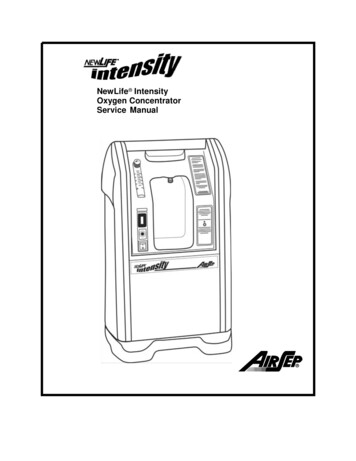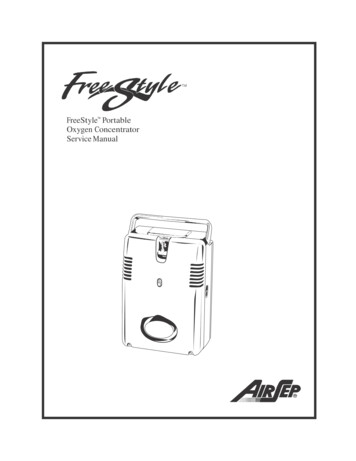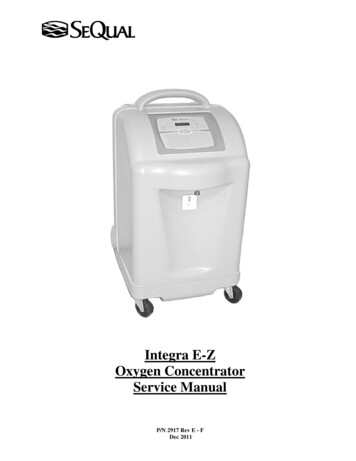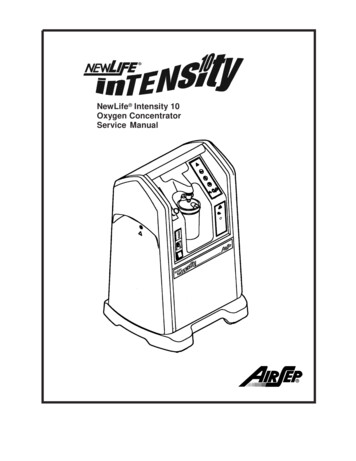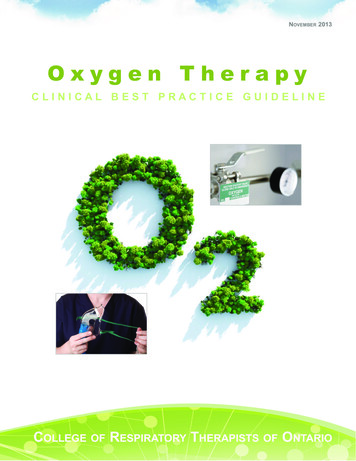
Transcription
NOVEMBER 2013Oxygen TherapyCLINICAL BEST PRACTICE GUIDELINECOLLEGEOFRESPIRATORY THERAPISTSOFONTARIO
Oxygen Therapy Clinical Best Practice GuidelineAcknowledgementsThis College of Respiratory Therapists of Ontario (CRTO or “the College”) Clinical Best Practice Guideline(CBPG) was developed by the Professional Practice Committee (PPC) of the CRTO in consultation withCouncil and other committees of the College, Members at large and staff.The PPC is a non-statutory committee comprised of Registered Respiratory Therapists (RRT) and publicmembers with a wide range of knowledge and experience from various practice areas across Ontario. Thiscommittee was formed by the CRTO in 2010 to focus specifically on the review and development ofstandards of practice directly related to the practice of Respiratory Therapy in Ontario. By having astanding committee of Respiratory Therapy leaders and experts from core areas of practice, and theability to draw on additional expertise where necessary, the CRTO aims to ensure consistency in thereview and development of publications in a timely fashion. The CRTO would like to acknowledge thework of the PPC, Members at large, and staff in the development of this new CBPG.Professional Practice Committee MembersPaul Williams RRT – Chair (CRTO Council Academic Member)Renee Pageau RRT – Vice Chair (CRTO Non-Council Member)Carol-Ann Whalen RRT (CRTO Non-Council Member)Allan Cobb (CRTO Public Council Member)Rhonda Contant RRT (CRTO Council Member)Daniel Fryer RRT (CRTO Non-Council Member)Alean Jackman RRT (CRTO Non-Council Member)Lori Peppler-Beechey RRT (CRTO Non-Council Member)Bruno Tassonse RRT (CRTO Non-Council Member)ConsultantsRaymond Janisse RRT Certified Hyperbaric Technologist (CHT)Bill Boyle, RRT (Certified Hyperbaric Technologist), MPA, CHEPast Professional Practice Committee Members (2010-2012)Marisa Ammerata RRT - Vice Chair (CRTO Council member)Jim Ferrie (CRTO Public Council Member)Ally Ruzycki-Chadwick RRT (CRTO Non-Council Member)Sherri Horner RRT (CRTO Member at large)Kevin Middleton RRT (CRTO Member at large)Carole LeBlanc RRT – Vice Chair (CRTO Non-Council Member)Dave Jones RRT (CRTO Council Member)Tracy Bradley RRT (CRTO Council Member)Mark Pioro (CRTO public Council Member)Resources and references are hyperlinked to the Internet for convenience and referenced to encourageexploration of information related to individual areas of practice and/or interests. Bolded terms aredefined in the Glossary.Originally Published: November 2013Page 2
Oxygen Therapy Clinical Best Practice Guidelinetable of contentsIntroduction Professional Practice Assumptions Guiding Principles Accountability Conflicts of Interest55678The Scope of this Clinical Best Practice Guideline Evidence Based Practice99Oxygen - A Brief Review Fast Facts about Oxygen Overview: Types of Oxygen Delivery Systems Compressed Gas Cylinders Liquid Oxygen in Cryogenic Containers Oxygen Concentrators for Medical Use Oxygen Safety at Home10101112141516Oxygen Therapy17 Health Canada & the Food and Drug Act An overview of the Phases of Drug Action Indications for Oxygen Therapy Absolute Contraindications & Potential Adverse Effects Goals of Oxygen Therapy Hypoxia Hypoxemia The Effects of Hypoxia & Hypoxemia Drive to Breathe and Carbon Dioxide Retention How does Oxygen Therapy work? Oxygen Transport Oxhemoglobin Dissociation Curve Gas Exchange (of Oxygen) Normal Diffusion of Oxygen Pathophysiological Factors Affecting Gas Exchange171819202121222324252526272829Page 3
Oxygen Therapy Clinical Best Practice Guidelinetable of contentsPage 4Oxygen Therapy Equipment and Adjuncts Guiding Principles Oxygen Delivery at the Patient/Client Interface Low Flow Oxygen Delivery Devices High Flow Oxygen Delivery Devices Nasal High Flow Oxygen Therapy Oxygen Therapy and Humidity Low Flow Oxygen Humidifiers High Flow Oxygen Humidifiers303132333333343434Special Considerations Neonatal Care Hyperbaric Oxygen Therapy Physiological Effects of Hyperbaric Oxygen Therapy Major Complications of Hyperbaric Oxygen Therapy Oxygen at High Altitudes353536373839Assessment of Oxygen Therapy Oximetry Pulse Oximetry Key Points to Remember40404041Glossary42References43
Oxygen Therapy Clinical Best Practice GuidelineIntroductionProfessional Practice AssumptionsIt is expected that all Respiratory Therapists (RTs) in Ontario possess the entry to practicecompetencies (i.e., knowledge, skills and judgment/abilities) to make sound clinical decisions regardingadministration of oxygen (O2) therapy as part of their education and clinical experience. In addition,the College assumes that all Members: Possess a specialized body of knowledge (e.g., about oxygen therapy); Are committed to maintaining a high standard of professional practice through selfgovernance; Are committed to lifelong learning and the development of knowledge, skills and abilitiesthroughout their career; Are committed to ongoing professional development; Are committed to the principle of accountability in their professional practice; and Are committed to practicing in an ethical manner.In addition, Members are expected to act only within their professional scope of practice and in thebest interest of their patients/clients. Please refer to the Standards of Practice and the CRTO’s positionstatement Scope of Practice and Maintenance of Competency.The purposes of this CBPG are to: Provide a framework for Respiratory Therapists to make informed patient care decisions aboutoxygen therapy that are safe and ethical; Provide a framework for clinical best practices regarding oxygen therapy that are current,evidence based and linked to up-to-date resources and learning materials; Support Respiratory Therapists in the maintenance of competency, support ongoingprofessional development and quality practice; and Provide the public and other health care professionals with confidence that RespiratoryTherapists are safe and ethical regulated health care professionals with the expertise toadminister oxygen therapy that results in positive health care outcomes for the public ofOntario.Self-RegulationSelf-GovernancePage 5
Oxygen Therapy Clinical Best Practice GuidelineGuiding PrinciplesTherapeutic oxygen should only be administered by competent healthcare providerswho possess the required competencies (knowledge, skill, and judgment/abilities) tomake clinical decisions regarding the administration of oxygen. The administration ofsubstances by inhalation is a controlled act under the Regulated Health Professions Act(RHPA) and is authorized under the Respiratory Therapy Act (RTA). The practice ofadministering oxygen therapy clearly falls within the legislated scope of practice ofRespiratory Therapy, which is:The Respiratory Therapy Act states that the Scope of Practice of aRespiratory Therapist is:The practice of respiratory therapy is the providing of oxygentherapy, cardio-respiratory equipment monitoring and theassessment and treatment of cardio-respiratory and associateddisorders to maintain or restore ventilation.Oxygen therapy is an expected competency of all Respiratory Therapists regardless ofthe practice setting. Respiratory Therapists work in a variety of practice settingsincluding but not limited to: Acute Care (Hospitals) Complex Continuing Care Long-Term Care. Independent Facilities (e.g., pulmonary function testing (PFT) labs, sleeplabs, ophthalmology clinics) Home Care Hyperbaric Oxygen Therapy Dental Anesthesia Independent Practice (e.g., consultants) Industry EducationPage 6
Oxygen Therapy Clinical Best Practice GuidelineAccountabilityOne of the many aims of this guideline is to provide resources and tools forRespiratory Therapists who are independently administering oxygen, to mitigate therisks that may be associated with independently administering oxygen therapy in theirclinical practice.Here are some guiding principles to consider: Be accountable and act in the best interest of your patients/clients atall times;Ensure safe and ethical care;Act within the scope of practice of the profession, the role and scope ofwhere you work and your individual scope of practice;Maintain the standards of your profession;Ensure that you are competent or become competent to do what you aregoing to do before you do it;Communicate with patients/clients and healthcare providers within thecircle of care;Educate your patients/clients and healthcare providers within the circle ofcare; andDocument Document Document!Did you know Circle of Care – Sharing Personal Health Information for HealthCare PurposesThe term “circle of care” is not a defined term in the PersonalHealth Information Protection Act, 2004 (PHIPA). It is a termcommonly used to describe the ability of certain healthinformation custodians to assume an individual’s impliedconsent to collect, use or disclose personal health informationfor the purpose of providing health care, in circumstancesdefined in PHIPA.To find out more visit the Information and PrivacyCommissioner of Ontario at www.ipc.on.ca.Page 7
Oxygen Therapy Clinical Best Practice GuidelineConflict of InterestA conflict of interest exists when you are receiving or are perceived to be receiving abenefit, from an individual or organization that could influence your professionaljudgment. The most common “benefit” is financial, but it is not the only kind of benefitthat may be received.It is professional misconduct to practice while in a conflict of interest.Conflicts of interest are more likely to occur in the community or home care settingwhere RTs deal with sales/billing, but may also occur in hospitals when RTs are advisingdischarged patients about respiratory equipment or service requirements.Respiratory Therapists must protect the trust relationship between themselves andtheir patients/clients. To do that, you should ensure that you do not place yourself in aposition where a reasonable patient/client, or other person, might conclude that yourprofessional expertise or judgment may be influenced by your personal interests, orthat your personal interests may conflict with your duty to act in the best interests ofyour patient/client. It is not necessary for your judgment to actually be compromised.Removing the conflict of interest can be achieved by disclosing to your patients/ clients(or their substitute decision maker), orally and in writing, that you will receive a benefitfrom the individual or organization before making any recommendation to thepatient/client to purchase equipment or services from that individual or organization.In order for patients/clients to make fully informed decisions you must disclose thecomplete nature of your relationship with the individual or organization, e.g., that youreceive financial compensation from the individual/organization for each purchasemade by a patient/client. In addition, you must advise the patients/clients orally and inwriting, that their care will not be affected if they choose to go elsewhere to purchasethat equipment/service. Providing a list of alternative sources for equipment/ servicesis strongly recommended.You may also wish to refer to other agencies’ policies and guidelines (e.g., Ministry ofHealth and Long-Term Care’s Assistive Devices Program (ADP) Conflict of Interest Policy,Veteran Affairs, etc.) and ensure that you are at all times adhering to the stricter ofCollege, employer or third-party requirements.Page 8
Oxygen Therapy Clinical Best Practice GuidelineThe Scope of this Clinical Best Practice Guideline (CBPG)Evidence-Based Practice“Evidence-based practice is the conscientious, explicit and judicioususe of current best evidence in making decisions about the care ofindividual patients/clients. The practice of evidence-based medicinemeans integrating individual clinical expertise and experience withthe best available clinically relevant evidence from systematicresearch” (Sackett et al., 1996).There is a vast amount of evidence-based, clinical information that is readily availableon the Internet, and this information is constantly changing. This CBPG is notintended to be an all-inclusive oxygen therapy manual or textbook. Rather, thisCBPG has been designed for use online and provides links to resources that can beused by RTs (and other users) to pursue their learning and professional developmentregarding best practices for oxygen therapy.Specific recommendations for the delivery of oxygen via mechanical ventilation(invasive and non-invasive) and other complex respiratory care devices is beyond thescope of this CBPG.This CBPG will not attempt to discuss the specific use of oxygen or prescribe targetoxygen saturations for the treatment of different pathophysiological presentations(e.g., COPD). Alternatively, links to additional evidence-based, clinical best practiceguidelines will be provided wherever possible (e.g., Canadian Thoracic Society’s COPDGuidelines).This CBPG is informed by the most current evidenced-based materials that wereavailable at the time of publication. For example, the British Thoracic Society’s (BTS’s)Guideline for Emergency Oxygen use in Adult Patients and the Canadian ThoracicSociety’s Guidelines. The CRTO is committed to maintaining up-to-date and accurateinformation to the best of its abilities and welcomes input regarding the bestpractices for oxygen therapy on an on-going basis.Page 9
Oxygen Therapy Clinical Best Practice GuidelineOxygen - A Brief ReviewOxygen (O2) is the eighth element on the periodictable.At ambient temperature and pressure (ATP), oxygenatoms bind together, sharing electrons to formmolecules of oxygen that exist as a colourless,odourless transparent and tasteless gas with thechemical symbol O2.Oxygen MoleculesFast Facts about O2 Makes up 20.9% of air by volume and 23% air by weight.Constitutes 50% of Earth’s crust by weight (in air water and combined withother elements).Can combine with all
oxygen saturations for the treatment of different pathophysiological presentations (e.g., COPD). Alternatively, links to additional evidence-based, clinical best practice guidelines will be provided wherever possible (e.g., Canadian Thoracic Society’s COPD Guidelines ). This CBPG is informed by the most current evidenced-based materials that were available at the time of publication. For .
